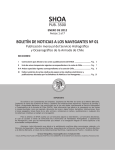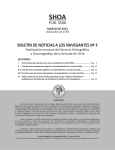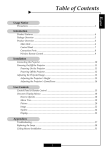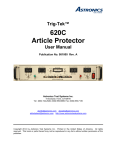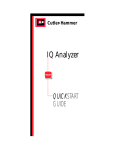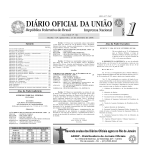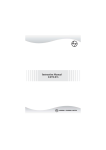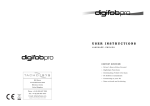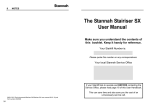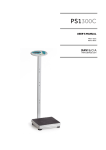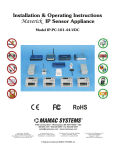Download 251 MANUAL
Transcript
LVU-251 User Manual V-01.01 (18.12.2006) GOVERNOR ELECTRONICO LVU - 251 FEATURES Speed sensor failure detection 12 and 24V operation Capable of governing various engines Forward acting actuator output Fast and accurate response Battery reverse voltage protection Output short circuit protection Rugged design Idle and rated speed modes Adjustable rated and idle speeds Isochronous and droop operation Enamel protected electronic circuit Small dimensions (130x110x27mm) Low cost Gain and stability adjustments External speed adjustment capability Synchronizing and load sharing input Switch mode output circuit 10 Amps continuous current output Aviador Zañartu # 2025 Conchalí – santiago www.luciovicencio.cl fono: 7345246 fono/fax: 7364198 URGENCIAS 09-8709358 LVU-251 User Manual V-01.01 (18.12.2006) TABLE OF CONTENTS Section 1. INSTALLATION 1.1. Introduction to the Control Unit 1.2. Mounting the Unit 1.3. Wiring the Unit 2. INPUTS AND OUTPUTS 3. OPERATION OF THE UNIT 4. STARTING THE ENGINE 5. OTHER FEATURES 5.1 Isochronous and Droop Operation 5.2 Idle Speed Selection 5.3 External Speed Adjustment 5.4 Speed Adjustment for Automatic Synchronization 5.5 Auxiliary power supply 6. TROUBLESHOOTING 7. DECLARATION OF CONFORMITY 8. TECHNICAL SPECIFICATIONS 9. CONNECTION DIAGRAM 10. INSTALLATION DIAGRAM Aviador Zañartu # 2025 Conchalí – santiago www.luciovicencio.cl fono: 7345246 fono/fax: 7364198 URGENCIAS 09-8709358 -2- LVU-251 User Manual V-01.01 (18.12.2006) 1. INSTALLATION 1.1 Introduction to the control unit The LVU-251 is a low cost electronic governor control unit designed to control the engine speed with fast and accurate response to load changes. The LVU-251 connects to a forward acting proportional electric actuator and a magnetic speed sensor. It is able to control a wide variety of engines in constant speed (isochronous) or droop modes. The optimal response, specific to each engine is easily reached using the gain and stability adjustments. The unit is capable to deliver actuator currents as high as 10 Amps. However the output circuit is protected against short circuits. Protection against reverse battery connection and transient voltages are provided. The unit is suitable for both 12 and 24V operation. 1.2 Mounting the Unit The unit is designed to be mounted inside a control cabinet. A vertical mounting position is preferred so that the water caused by condensation could be drained away. Extreme heat may affect the performance of the unit and should be avoided. 1.3 Wiring the Unit The electrical connections of the unit are illustrated in chapter 9. Cables of section 1.5mm² or higher should be used for battery and actuator connections (terminals A-B-E-F). The section needs to be increased with long cables. WARNING: THE UNIT IS NOT FUSED. Use external fuse for battery positive (terminal F) Install the fuse as nearly as possible to the unit. The fuse rating should be 16 Amps. The signal connections on terminals C-D-G-H-J-K-L should be twisted or shielded for the entire length of the cable. The shield should be grounded at one end only. The other end of the shield should be left unconnected in order to avoid current flowing through it. The gap between the magnetic speed sensor and the ring gear teeth should not be less than 0.50mm (0.020”). The usual way of adjusting the gap is backing up the sensor ¾ turn after touching the ring gear teeth. The magnetic speed sensor voltage should be at least 1.5 VAC RMS during cranking. WARNING: Do not rely exclusively on the governor controlleractuator system for engine overspeed protection. An independent overspeed shutdown unit controlling the fuel solenoid should be installed on the engine. Aviador Zañartu # 2025 Conchalí – santiago www.luciovicencio.cl fono: 7345246 fono/fax: 7364198 URGENCIAS 09-8709358 -3- LVU-251 User Manual V-01.01 (18.12.2006) 2. INPUTS AND OUTPUTS Term Function A ACTUATOR + B C D E F G H J K L M N P Technical data Output, 10A max Description These outputs supply energy to the electric actuator. The output voltage will ACTUATOR increase in order to supply more fuel to the engine. A short circuit protection is provided. Magnetic pick-up Input, 1-35VAC- Connect the magnetic pickup terminals to RMS these inputs. The input voltage cannot be less than Magnetic pick-up 1VAC-RMS. A signal of at least 3 VACRMS is recommended. The cable should be either twisted or shielded. Battery Input, 12 / 24V Power supply connection. Use cables of adequate section for the actuator. Battery + Speed trim / increase Input Speed trim potentiometer and increase droop droop switch input. Internally connected to battery (-). Increase droop Input Increase droop switch input. Speed trim Input Speed trim potentiometer input. The cable should be either twisted or shielded. Droop Output Connecting this terminal to terminal L will cause DROOP operation. The DROOP range is adjusted with the DROOP potentiometer. Droop/Idle Input Droop mode and Idle speed setting input. Idle speed select Output Connecting this terminal to terminal L will switch to IDLE SPEED operation. The IDLE SPEED is adjusted with the IDLE potentiometer. External speed adjust Input, 0-10 VDC The external speed adjustment voltage should be connected to this input. The cable should be either twisted or shielded. Auxiliary power supply Output, 10V 20mA Supply output for external devices. WARNING: Do not shortcircuit this output. Otherwise the unit may get damaged. Aviador Zañartu # 2025 Conchalí – santiago www.luciovicencio.cl fono: 7345246 fono/fax: 7364198 URGENCIAS 09-8709358 -4- LVU-251 User Manual V-01.01 (18.12.2006) 3. OPERATION OF THE UNIT The unit is designed to operate from a DC supply of 12 or 24 volts, which is usually the start battery. The battery is connected to terminals E and F. A reverse polarity protection is provided. The unit should be supplied with a speed signal at the inputs C and D. The signal comes usually from a magnetic pickup unit mounted in close proximity of the engine ring gear. The frequency of the speed signal is proportional to the engine rpm. The minimum acceptable amplitude of the speed signal is 1 VAC-RMS. The acceptable frequency range is 500 Hz to 8’000 Hz. The use of a shielded cable is recommended. The shield should be grounded at one end only. The terminal D is internally connected to ground. The actuator output is energized only when a speed signal is present. An internal signal detection circuit will shut-off the actuator if an adequate signal is not connected to the inputs. The engine speed is adjusted with a multi-turn potentiometer. This will allow a precise adjustment of the desired engine rpm. The stability of the speed is adjusted with the GAIN and STABILITY potentiometers. These potentiometers will modify the dynamic response of the unit to speed changes and allow adaptation to different type of engines. The GAIN potentiometer adjusts the reaction rate of the unit to speed changes. The unit will become more sensitive as the potentiometer is turned clockwise. This will allow a faster return to the nominal speed when a load change occurs. Do not forget that excess gain will cause instability. The STABILITY potentiometer injects a delay to the unit’s reaction to speed changes. This will permit to match the unit to the engine size. The unit will become faster as the potentiometer is turned clockwise. This will allow a faster return to the nominal speed when a load change occurs. Do not forget that too fast response will cause instability. When the engine is stopped, the signal presence detection circuit will shut-off the actuator. During cranking, the speed signal will be well below the nominal speed, which causes the actuator to open fully. When the engine is fired, the actuator will stay open until the engine reaches the preset speed. Then the actuator will be supplied only with the amount of current necessary to maintain the preset speed. A sudden load increase on the engine shaft will result to a speed drop. This will cause the actuator to open more in order to reach the preset speed. A sudden load decrease will cause a speed increase. This will cause the actuator to shut-off gradually until reaching again the preset speed. The actuator output is a switch mode circuit which supplies nearly the battery voltage when turned on. This allows the unit to deliver high output currents with minimum self heating and a very good efficiency. The switching frequency is well above the natural oscillation frequency of the actuator moving parts and will not cause a visible effect. Aviador Zañartu # 2025 Conchalí – santiago www.luciovicencio.cl fono: 7345246 fono/fax: 7364198 URGENCIAS 09-8709358 -5- LVU-251 User Manual V-01.01 (18.12.2006) 4. STARTING THE ENGINE Before starting: Do not modify the speed setting. Check that all other potentiometers are set to midcourse. Starting the engine: Apply the DC power to the unit. The actuator should be closed. Crank the engine. The actuator should open completely. When the engine is running, adjust the gain and stability potentiometers counterclockwise until the engine is stable. Adjust the nominal speed. The speed will increase when the SPEED potentiometer is turned clockwise and it will decrease when the SPEED potentiometer is turned counterclockwise. Adjusting the response: Turn the GAIN potentiometer clockwise until the instability is reached, then gradually come back until the stability returns. Turn one division counterclockwise for safety. Turn the STABILITY potentiometer clockwise until the instability is reached, then gradually come back until the stability returns. Turn one division counterclockwise for safety. If stability cannot be reached please check the Troubleshooting section. 5. OTHER FEATURES 5.1 Isochronous and Droop Operation The typical operation mode of the unit is isochronous (constant speed). However a droop operation may be required for load sharing purposes on genset engines. In droop operation, the engine speed with decrease slightly with load increase. The load information is picked up from the actuator current, which increases together with the load. The droop operation is selected by connecting together the terminals K and L. The amount of droop is adjusted with the related potentiometer. The droop range may be increased by connection together terminals G and H. The droop range will be different for each engine-actuator combination. For a current increase of 1 Amperes, the droop range is adjustable within 1 to 5 % of the nominal speed. The droop adjustment modifies also the speed setting, thus it is necessary to readjust the no-load speed after droop adjustment. Aviador Zañartu # 2025 Conchalí – santiago www.luciovicencio.cl fono: 7345246 fono/fax: 7364198 URGENCIAS 09-8709358 -6- LVU-251 User Manual V-01.01 (18.12.2006) 5.2 Idle Speed Selection The unit offers the possibility of Idle/Nominal speed switching using an external switch. The idle speed is independently adjustable with a separate trimpot. The idle speed is increased with the clockwise rotation of the adjustment trimpot. Switching between idle and nominal speeds can be done while the engine is running. 5.3 External Speed Adjustment An external speed adjustment potentiometer can be connected between terminals G and J. The potentiometer value should decrease with a clockwise rotation (speed increase). The recommended potentiometer value is 5 K-ohms. A different value may also be used for an exact match of the desired adjustment range. The external adjustment cable should be shielded for the best operation. The cable should be shielded at one end only. 5.4 Speed Adjustment for Automatic Synchronization External speed adjustment signal from other control devices may be applied between terminals N and G (ground). The input accepts 0 to 10V DC signals. The remote speed adjustment cable should be shielded for the best operation. The cable should be shielded at one end only. 5.5 Auxiliary power supply An auxiliary power supply of 10V-DC / 20mA is provided. WARNING: Be carefull to not to short-circuit the output, this may damage the unit. Aviador Zañartu # 2025 Conchalí – santiago www.luciovicencio.cl fono: 7345246 fono/fax: 7364198 URGENCIAS 09-8709358 -7- LVU-251 User Manual V-01.01 (18.12.2006) 6. TROUBLESHOOTING The actuator is inoperative: 1) Measure the DC-supply voltage between terminals F(+) and E(-) of the unit. You should read the battery voltage, if not: a) Check for a blown fuse b) Check connections and wiring 2) With the unit powered-up, measure the DC voltage between terminals P(+) and G(-). You should read 10V-DC (±1V). If not: a) The unit may be damaged due to a short circuit on terminal P. 3) With the unit powered-up, momentarily connect terminals A and F. The actuator should open completely. If not: a) Check a mechanical obstruction on the actuator lever manually. b) Measure the DC voltage on the actuator terminals: If the battery voltage is present, then the actuator is damaged. If there is no voltage, then check the actuator wiring. c) If the fuse blows, then check a short circuit in the wiring. 4) Crank the engine. Measure the AC voltage between terminals C and D. It should be at least 1VAC_RMS. If not: a) Check the gap between the speed sensor and the gear teeth. If needed then readjust it as described in chapter 1.3 b) Check wiring. c) The speed sensor may be defective. 5) Crank the engine. Measure the DC battery voltage while cranking. It should be above 8 VDC for a 12V system and 16V for a 24V system. If below: a) The battery is weak or discharged. 6) If the battery voltage is correct: a) Speed adjustment set too low, readjust. b) The unit is defective. The engine speed is too low: 1) Check the speed setting. 2) While engine running under governor control, measure the DC voltage between terminals A and B. If the voltage is close to the battery voltage: a) the actuator lever is mechanically obstructed from moving until full fuel position. Check mechanically that the lever has enough freedom of movement. b) The spring mechanical resistance is too strong for the actuator. Check with a softer spring. c) Check for misalignments and frictions on the actuator-fuel lever systems. Aviador Zañartu # 2025 Conchalí – santiago www.luciovicencio.cl fono: 7345246 fono/fax: 7364198 URGENCIAS 09-8709358 -8- LVU-251 User Manual V-01.01 (18.12.2006) Engine overspeeds: Do not crank again. 1) With the unit powered-up, if the actuator opens fully: a) Disconnect wiring at terminals C and D. If the actuator closes then the speed signal is faulty, probably due to electrical noises. Check shielding and wiring. If the actuator is still open, then disconnect the terminal A. If the actuator is still open, then the actuator is feeded by an external connection or short circuit. If the actuator shuts-off then the unit is damaged. 2) Run the engine and hold the fuel lever manually with the engine at the requested speed: a) Readjust the speed by rotating the speed trimpot counterclockwise. If desired speed cannot be reached then the unit is faulty. Speed unstable: 1) Readjust GAIN and STABILITY as desribed in chapter 4. 2) Check the speed sensor for: a) Signal strength b) Wiring c) Shielding 3) Check the actuator-fuel lever system for loose mechanical linkage, or friction: a) Make the checks while the engine is operating. 4) Check for electromagnetic disturbance sources in close proximity as: a) battery chargers b) ignition systems c) radio transmitters. Make a test by turning them off mometarily. If the stability cannot be reached, then enclose the unit in a separate and grounded metal sheet cabinet. Systems in very harsh electromagnetic conditions as found in close proximity of powerful transmission systems may require shielding on all cables and even special EMI shielding. 5) Check the engine fuel and injection system: Faulty injectors, blocked filters etc… may prevent the governor controller to maintain a constant speed. Aviador Zañartu # 2025 Conchalí – santiago www.luciovicencio.cl fono: 7345246 fono/fax: 7364198 URGENCIAS 09-8709358 -9- LVU-251 User Manual V-01.01 (18.12.2006) 7. DECLARATION OF CONFORMITY The unit conforms to the EU directives -73/23/EEC and 93/68/EEC (low voltage) -89/336/EEC, 92/31/EEC and 93/68/EEC (electro-magnetic compatibility) Norms of reference: EN 61010 (safety requirements) EN 50081-2 (EMC requirements) EN 50082-2 (EMC requirements) The CE mark indicates that this product complies with the European requirements for safety, health environmental and customer protection. 8. TECHNICAL SPECIFICATIONS DC Supply Range: 10.0 to 33.0 V-DC Current consumption: 60mA (actuator not connected) Speed input range: 500 Hz to 8000 Hz. Speed signal amplitude: 1 to 35VAC-RMS Speed signal input impedance: 10 K- ohms External speed trim: 5 K-ohms trimpot between terminals G and J External speed trim range: ± 6% min @3000Hz Auxiliary input (terminal N): Input voltage range: 0 to 10VDC Input impedance: 1M ohms. Adjustment range: ±25% min @3000 Hz Steady state speed accuracy: ±0.25% Droop adjustment range: 1 to 5% minimum Actuator output: 10 Amps continuous max DC supply output: 10 volts DC, 20mA max Operating temp.: -20°C (-4°F) to 70 °C (158°F). Storage temp.: -30°C (-22°F) to 80 °C (176°F). Maximum humidity: 95% non-condensing. Dimensions: 130 x 110 x 27 mm (WxHxD) Weight: 350 g (approx.) Mounting: any position, vertical preferred Aviador Zañartu # 2025 Conchalí – santiago www.luciovicencio.cl fono: 7345246 fono/fax: 7364198 URGENCIAS 09-8709358 - 10 - LVU-251 User Manual V-01.01 (18.12.2006) 9. CONNECTION DIAGRAM Aviador Zañartu # 2025 Conchalí – santiago www.luciovicencio.cl fono: 7345246 fono/fax: 7364198 URGENCIAS 09-8709358 - 11 - LVU-251 User Manual V-01.01 (18.12.2006) 10. INSTALLATION DIAGRAM Aviador Zañartu # 2025 Conchalí – santiago www.luciovicencio.cl fono: 7345246 fono/fax: 7364198 URGENCIAS 09-8709358 - 12 -













